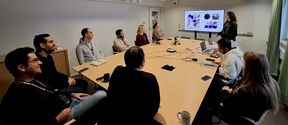Lignin nanoparticles: A sustainable recipe for combining cellulose with hydrophobic polymers for advanced applications

The material is made through an innovative combination of wood-based and biodegradable polymers without any chemical modification, harnessing the maximum benefit of each component. For the co-authors in this study, sustainability is a significant motivator in understanding the chemistry of how these materials could work together and developing materials of tomorrow with the functionality we expect today.
Cellulosic materials, which come from the cell walls of plants, have emerged as attractive, sustainable replacements for traditional plastics. However, the moisture sensitivity of cellulose and its incompatibility with many soft hydrophobic polymers are challenges to their widespread application.
From a materials design perspective, gaining the benefit of both hydrophilic cellulose and hydrophobic polymers at the same time without any chemical treatment of raw materials is mystifying. But what if we could engineer their interface with a third component, having favorable interactions with both cellulose and soft polymers such as polycaprolactone (PCL)? To achieve this goal, the team demonstrated that lignin nanoparticles with their well-defined morphology and active surface sites can interact with both cellulose, in this case cellulose nanofibrils, and PCL and act as a compatibilizer between hydrophilic cellulose and hydrophobic PCL. Although it looks complex, the solution is simple.
First, PCL dissolved in an organic solvent is mixed with the lignin nanoparticles in water. The lignin particles assembles at the oil water interface and stabilize the emulsion. Emulsions stabilizes with solid particles are called Pickering emulsions. This emulsion is then mixed with aqueous CNF suspension prior to film formation. This Pickering emulsion strategy creates an even dispersion of a polymer within the cellulose network, increasing the wet strength and water resistance of the composite, meanwhile retaining all the positive characteristics of the cellulose fibers or fibrils. The outcomes are excellent: the developed composite has a higher strength than pure CNF nanopaper or pure polymer in both dry and wet conditions, even after fully immersing it in water for a day. 'When the film was taken out of the water, it looked exactly the same as when it was put into the water,' says Kimiaei. The reason for this is that the hydrophobic polymer, with the aid of the lignin nanoparticles is now covering the cellulose surface protecting it from the water.
The composite revealed wet strength up to 87 MPa, the highest obtained wet strength for cellulosic composites developed without any direct covalent surface modifications or synthetic additives. Furthermore, this strategy added additional functionality, such as UV shielding and antioxidant properties to the developed composites, making them interesting for packaging applications.
The team at Aalto University in Finland, a country that arguably has the world’s leading experts in the forestry industry, is focused on making the most of these natural and industrial resources. 'Building the future with forests requires a commitment to sustainable forest management and creating additional value beyond the typical biorefinery and pulp and paper industry,' says co-author Erfan Kimiaei, a doctoral candidate at Aalto University, School of Chemical Engineering. 'Understanding the interfacial chemistry of wood components can be the key to getting the most out of this valuable resource in building the sustainable future,' professor Monika Österberg adds.

For experts in the field, this approach opens new possibilities to eliminate the need for cellulose chemical modification to impart new functionalities, promoting the sustainable use of natural resources from the forest. Furthermore, this research offers a generic foundation for combining hydrophilic cellulose with varied hydrophobic soft polymers to design multifunctional cellulose-based composites using only biodegradable polymers and lignocellulosic materials, taking a big step toward fully sustainable use of natural resources. As a follow up, the researchers are now exploring a broad framework to identify the sustainability of this early-stage technology in environmental and economic aspects by integrating techno-economic and life cycle assessments.
The study is published in the Advanced Materials Interfaces journal on 25.8.2022.

Further information:
Erfan Kimiaei, Doctoral candidate, Aalto University
Erfan.kimiaei@aalto.fi, +358504360658
Muhammad Farooq, Postdoctoral researcher, Aalto University
Muhammad.farooq@aalto.fi
Monika Österberg, Professor, Aalto University
Monika.osterberg@aalto.fi
Read more news

Join Unite's Well-Being Workshop Series
The interactive Zoom sessions are designed to support doctoral students’ well-being, strengthen a sense of belonging, and offer practical tools for success in their academic journey.Create your CV easily with the Research.fi profile tool
Aalto University’s researchers can now create a CV using the CV tool in the Research tool service. The tool generates an editable Word CV based on your Research.fi profile information, following the official TENK CV template.Apply to be a guest professor or visiting researcher at the Université Grenoble Alpes
Unite! partner, Université Grenoble Alpes (UGA) has opened a call to host international professors and researchers for short stays.






